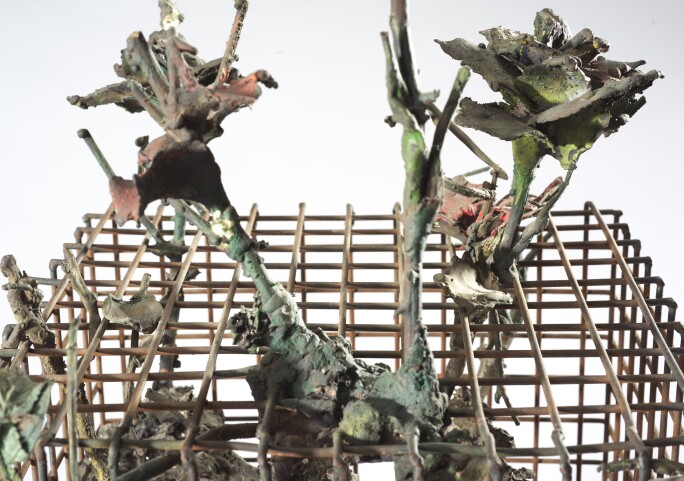In 1968-1969, in particular, Cavaliere worked on a cycle of works entitled W la libertà in which the natural elements are enclosed in metal gulls that prevent them from expanding and, almost, from breathing. These works are of immediate, even didactic eloquence, and allude to the discomfort of civilization, to social conventions that repress instinct, to the unnaturalness and lack of freedom of contemporary life. If originally, as in Lucrezio, nature has no limits (Nec res praefiniet ulla), in today's society it appears blocked, constrained, imprisoned.

Beyond the contents, however, it is not less important, even if it is less evident, the stylistic need from which the cycle W la libertà is born. As in some of the sequences of G.B. [Gustavo B., a man without qualities and the author's alter ego, the main character of a play in various acts that recounts his life, the plot of his relationships with his family, his affections, nature, society, work and death], here too Cavaliere feels the need to combine the linear elements of his Arbres with volumetric elements, and to place the organic forms of bushes and flowers alongside the squared orthogonal forms of the cage.
Elena Pontiggia, "Giardino delle metamorfosi", in Alik Cavaliere Catalogo delle sculture, Milan 2011, p. 26
Nel 1968-1969, in particolare, Cavaliere lavora a un ciclo di opere intitolate W la libertà in cui gli elementi naturali sono rinchiusi in gabbie metalliche che impediscono loro di espandersi e, quasi, di respirare. Sono opere , queste, che di immediata, perfino didascalica eloquenza, e alludono al disagio della civiltà, alle convenzioni sociali che reprimono l'istinto, l'innaturalità e alla mancanza di libertà della vita contemporanea. Se originariamente, lucrezianamente, la natura non ha limiti (Nec res praefiniet ulla), nella società attuale appare invece bloccata, costretta, imprigionata.
Al di là dei contenuti, però, non è meno importante, anche se è meno evidente, l'esigenza stilistica da cui il ciclo W la libertà nasce. Come in alcune sequenze di G.B. [Gustavo B., uomo senza qualità e alter ego dell'autore stesso, protagonista di una pièce in vari atti che racconta la sua vita, la trama delle sue relazioni con la famiglia, gli affetti, la natura, la società, il lavoro, la morte.], anche qui Cavaliere sente il bisogno di accostare gli elementi linearistici dei suoi Arbres ad elementi volumetrici, e di affiancare alle forme organiche di cespugli e fiori quelle ortogonali e quadrettate della gabbia.
Elena Pontiggia, "Giardino delle metamorfosi", in Alik Cavaliere Catalogo delle sculture, Milano 2011, p. 26

